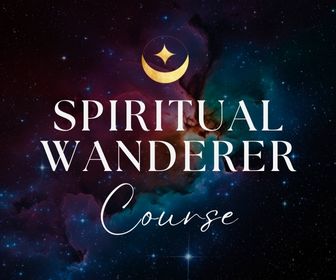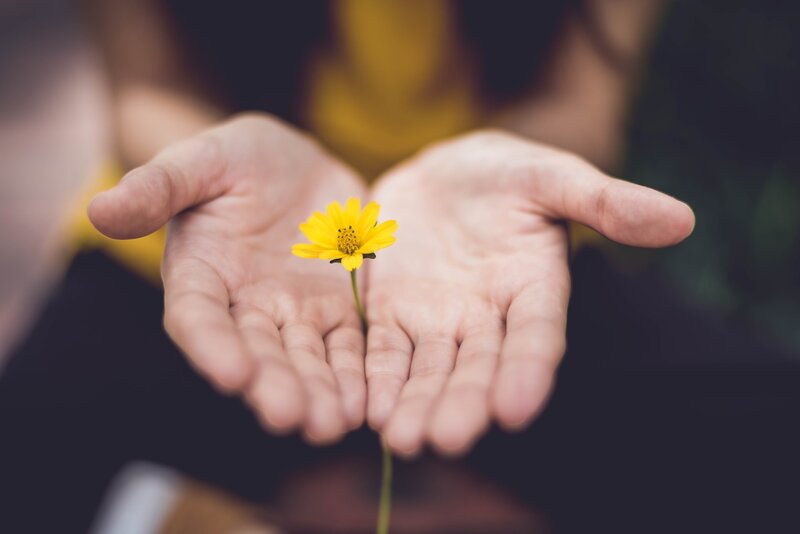Spiritual meditation is different from mainstream meditation in that it focuses on connecting with something greater and deeper than ourselves.
Normal meditation – the kind you read about in journalist columns, hear about in talk shows, and watch on the news – is a great first step in the door.
With the extensive research backing meditation, it’s no wonder that people with little to no interest in spirituality are doing it.

Spiritual Wanderer Course:
Find your deepest path and purpose in life as a spiritual wanderer. In this immersive course, you get 3+ hours of content, workbooks, meditations, a premium test, and more!
But if you’re a soul seeker and spiritual sojourner, you might crave to find extra meaning, depth, and value in your meditation practice.
This article can help open some doorways for you in a simple, concise way.
Table of contents
What is Spiritual Meditation?

Spiritual meditation is a way of reconnecting with Spirit – or the Divine force and Higher essence of life.
During spiritual meditation, it’s not uncommon to have experiences of:
- Mystical experience
- Ego death
- Deep insights into the nature of self/reality
- Kundalini (spiritual) energy
- Spiritual Oneness and expansion
- Inner peace
Some people even report altered states of consciousness that feel similar to out-of-body experiences.
While we don’t always have these profound experiences, they’re more likely to happen when we orient ourselves to a more spiritual form of meditation.
Types of Spiritual Meditation

One conscious breath in and out is a meditation.
– Eckhart Tolle
Historically there have been many different forms of spiritual meditation present throughout ancient religions. Most of these types of spiritual meditation are still available to us today. Examples include:

Shadow & Light Membership:
⭐️⭐️⭐️⭐️⭐ "Shadow and Light’s weekly guidance always rings true to my heart. Thanks for acknowledging my shadows and inviting my inner light. I always get excited to open the Shadow and Light emails on Sunday!" – Angela M.
- Vipassana (or insight) meditation
- Metta (loving-kindness) meditation
- Mantra meditation
- Zazen meditation
- Daoist meditation
- Gazing (‘Trataka’) meditation
There are also more modern forms of meditation, often derived from older techniques. Examples include:
- Transcendental Meditation®
- Self-Inquiry (Ramana Maharshi) meditation
- Visualization meditations (e.g., chakra, healing light)
- Kriya yoga
- Sound meditation
- Kundalini meditation
While this isn’t an exhaustive list of spiritual meditation practices, it should give you a pretty good idea of what’s out there!
Spiritual Awakening & Meditation (Plus a Warning)

When you contemplate the nature of Self, you are meditating. That is why meditation is the highest state. It is the return to the root of your being, the simple awareness of being aware. Once you become conscious of the consciousness itself, you attain a totally different state. You are now aware of who you are. You have become an awakened being. It’s really just the most natural thing in the world.
– Michael A. Singer
Certainly, spiritual meditation can help to deepen your spiritual awakening journey. It can help you to experience more calmness, openness, love, and freedom.
But at the same time, I must give a word of warning:
Be very gentle with yourself as you explore the world of spiritual meditation. Practice self-love and self-care by tuning into what works for you and what doesn’t.
In some extreme cases, spiritual meditation techniques can trigger a spiritual emergency where the ego (or self-identity) becomes totally destabilized.
So go slowly in your exploration and soul searching. Speaking from experience, I know how debilitating meditation can be when not approached with a sense of gentleness.
For instance, I once went so deep into meditation that a traumatized and destructive part of my psyche was beckoned from “the deep.” I had to seek out professional opinion to know how to handle this unexpected side effect from meditation.
Remember to listen to and respect your mental, emotional, and physical well-being.
Spiritual Meditation in a Nutshell – 11 Enlightening Paths

Prayer is when you talk to God; meditation is when you listen to God.
– D. Robinson
The world of spiritual meditation can be a little overwhelming – let’s be frank here!
Would you like to save this?
Your information will never be shared.
Meridians, mantras, mudras, breathwork techniques, lectio divina … it can all get a little too much.
So to help you navigate the labyrinth of information, I’ve summarized eleven spiritual meditation paths below.
Take these bite-sized summaries slowly. Also know that they are (obviously) not comprehensive, but are instead meant to be nuggets of information that can help you make a decision about what may best suit you.
I have not included Transcendental Meditation® here as this technique is not taught freely. You must pay to receive direct guidance and ongoing support. If that sounds like it resonates with you, check out their website.
Here are eleven simplified spiritual meditation paths:
1. Vipassana meditation
Vipassana means ‘insight.’ It’s one of the most ancient spiritual meditation practices, being taught in India over 2,500 years ago. The purpose of it is to have a crystal clear awareness of what is happening within you, at the exact moment it happens. The goal is to help you experience Spiritual Liberation. Focusing on one’s breath, mental noting, body scanning, and contemplating the nature of impermanence are practices often used during Vipassana.
2. Metta meditation
Metta means ‘loving-kindness’ and is a more heart-centered form of spiritual meditation. It derives from Buddhist philosophy and involves cultivating compassion toward oneself and others. You begin by wishing yourself well and saying “May I be happy, may I be well” (or similar). You then think of a loved one and mentally wish them the same: “May you be happy, may you be well.” Finally, you think of someone you feel neutral toward, perhaps a co-worker. Wish them happiness. Finally, bring to mind an enemy or someone you struggle with and wish them happiness.
3. Mantra meditation
Mantra meditations can be found in a range of different religions – from Christianity and Islam to Hinduism and Jainism. Essentially, mantra meditation involves choosing one powerful word, phrase, or sentence and repeating it continuously. Common mantras include: “Om,” “Om Namah Shivaya,” “I am,” “Om Mani Padme Hum,” “So Ham,” “Elohim,” “Hare Krishna,” “Gate gate paragate parasamgate bodhi svaha.” The goal of mantra meditation is enlightened consciousness.
4. Zazen meditation
Zazen, or zen meditation, derives from Zen Buddhism. The goal is to free the mind, find inner peace, and perceive the nature of existence. Zazen practitioners generally focus on cultivating open awareness (simply letting things come and go in your mind) and focusing on the breath. Correct posture is also emphasized by Zazen as the body and mind are seen as one. Interestingly, researchers have found a correlation between practicing Zazen and a greater access to the unconscious mind.
5. Daoist meditation
Daoist, or Taoist meditation, stems from the Chinese religion and philosophy of Taoism. There are a number of techniques that involve contemplation, visualization, and mindful awareness. The emphasis of Daoist meditation is to create mind-body harmony by balancing the life force energy and entering the Tao (Spirit).
6. Gazing meditation
Gazing meditation, also called Trataka (Sanskrit for ‘to gaze’) is a way of sharpening our inner focus by focusing on something outside of ourselves. Usually, gazing meditation involves meditating on a flame as fire is said to cleanse the third eye chakra. However, there are other forms of gazing meditation such as meditating on a sacred symbol (such as a yantra) or object in our surroundings. The goal is to help you eventually shift to internal seeing or self-realization.
7. Self-inquiry meditation
This form of spiritual meditation was developed by Indian Hindu sage, Ramana Maharshi. The technique essentially involves repeatedly asking the question, “Who am I?” With time, the stories and blockages of the mind dissolve. The goal is to recognize our True Nature as Pure Awareness.
8. Visualization meditation
As an umbrella term, visualization meditation encompasses many different practices and techniques. Just like the name suggests, visualization meditation involves visualizing or imagining some kind of healing image. Common forms involve visualizing the chakras, a healing light, a peaceful place, colors, a guru/deity, or a sacred symbol. The goal is more of a holistic sense of healing, well-being, and happiness.
9. Kriya yoga
While kriya yoga is a yogic technique, it’s also a meditative practice. In fact, this form of spiritual meditation is a complete spiritual path in and of itself. Indian guru Paramhansa Yogananda is credited with popularising this practice. Kriya, a Sanskrit word that means action, points to the goal of this avenue of spiritual evolution which is to actively use the breath to move energy up and down the spine. The result, according to practitioners, is accelerated spiritual transformation.
10. Sound meditation
Sound meditation is another ancient practice of spiritual meditation. From the ancient Australian Aboriginal use of the didgeridoo to Tibetan Singing Bowls and the pipe organs in European Cathedrals, sound meditation offers tremendous variety. The entire practice is usually very simple: close your eyes and bring your attention to a certain sound. Modern forms of sound healing often incorporate crystal singing bowls, tuning forks, pan drums, and windchimes. You can choose to play these instruments or simply listen to them on your phone.
For over 12 years, we've poured our hearts into creating free content on this website. Unlike many platforms, we believe this guidance should be accessible to everyone. If this post empowered you in any way, please consider making a donation to keep us going. Any amount (one-time or ongoing) makes a huge difference.
11. Kundalini meditation
Kundalini meditation is one of the more complex – and dangerous – forms of spiritual meditation out there. These two facts alone are enough to make most people’s ears prick up and fuel the desire to excitedly jump headfirst into this practice. But be gentle. Seek out a trained (and competent) practitioner. This practice can have serious side effects if not approached wisely. In a nutshell, kundalini meditation involves awakening the kundalini – or spiritual – energy at the base of the spine. It involves focusing on the chakras, the repetition of a mantra, mudras (yogic hand gestures), and breathing techniques. (Read more about kundalini awakening.)
How Do I Choose the Right Form of Spiritual Meditation For Me?

With so many illuminating paths out there, which one do you commit to?
My answer is to pay attention to which one ‘calls’ to you. In other words, which one generates a strong emotion like intrigue, excitement, or awe?
If none call to you, reflect on what you would like to ‘get out of’ spiritual forms of meditation. For instance, perhaps you want to experience more inner peace, balance your energy, cultivate compassion, improve your health, or deepen your spiritual awakening.
Once you have decided, commit to the practice. (After all, how else will you discover the benefits or learn whether that practice is right for you or not?)
If you can, set aside six months minimum to one meditation practice.
Of course, if you’re experiencing negative side effects, stop it immediately.
But otherwise, get into the habit of practicing that spiritual meditation technique each day for at least 10 minutes.
Reading books, watching videos, and attending classes can help deepen your understanding of your chosen spiritual meditation technique.
***

Meditation will not carry you to another world, but it will reveal the most profound and awesome dimensions of the world in which you already live.
– Zen Master Hsing Yun
Finally, remember that the goal of spiritual meditation isn’t to escape this reality. The goal is to help you awaken you to it, within it.
Meditation is a path of embracing both your humanity and divinity as the divine paradox that you are.
So tell me, what spiritual meditation path calls to you? Have you had any amazing experiences that you’d like to share to inspire and support others here?
Whenever you feel the call, there are 2 ways I can help you:
1. The Soul Work Compass Course: Ready for deep transformation without the fluff? The Soul Work Compass provides a step-by-step path to finding your inner truth and life direction. Heal core wounds, clarify your values, and walk away with a concrete guide for living. Get started now!
2. The Inner Work Journal Bundle: Stop surface-level healing. Dive into the depths with 150+ journaling prompts designed to help you face your demons, heal childhood wounds, and embrace your shadow. Three sacred journals, lifetime access, print as many times as you need. Real transformation starts here.







I am intrigued by the Vipassana, trataka, and Kundalini meditation styles. However, I have the most meditation experience with mindfulness, creative visualization/guided imagery, and sound healing.